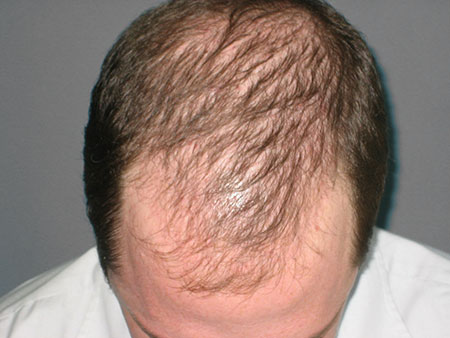Hair is usually lost in a well-defined pattern, beginning above both temples. Over time, the hairline recedes to form a characteristic “M” shape. Hair also thins at the crown (near the top of the head), often progressing to partial or complete baldness.

The pattern of hair loss in women differs from male pattern baldness. In women, the hair becomes thinner all over the head, and the hairline does not recede. Androgenetic alopecia in women rarely leads to total baldness.
Androgenetic alopecia in men has been associated with several other medical conditions including coronary heart disease and enlargement of the prostate, a walnut-sized gland in males that is located below the bladder. Additionally, prostate cancer, disorders of insulin resistance (such as diabetes and obesity), and high blood pressure (hypertension) have been related to androgenetic alopecia. In women, androgenetic alopecia is associated with an increased risk of polycystic ovary syndrome (PCOS). PCOS is characterized by a hormonal imbalance that can lead to irregular menstruation, acne, excess body hair (hirsutism), and weight gain.
How common is androgenetic alopecia?
Although androgenetic alopecia is a frequent cause of hair loss in both men and women, it is much more common in men. This form of hair loss affects an estimated 35 million men in the United States alone.
Androgenetic alopecia can start as early as a person’s teens and risk increases with age; more than 50 percent of men over age 50 have some degree of hair loss. Androgenetic alopecia is often hereditary. In other words, if losing ones hair is a family trait, it is highly likely that those further down the family tree will also be affected.
Can Androgenetic alopecia be treated?
Yes. For more information, please see our Alopecia Treatment page, our case studies and our gallery.
